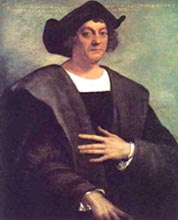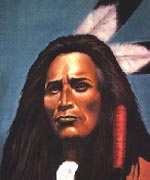|
● A
New Land
● Europe
in the 16th and 17th Centuries
● The
Settlement in Virginia
● Puritan
New England
● Catholic
Maryland
● Quaker Pennsylvania
● The
American Revolution
Text
 What
is an American? This has become a classic question asked not only
by foreigners visiting the United States, but more often by Americans
themselves. When Americans feel confused or when they are in a crisis,
they ask who they are and try to find out what being an American
means. In fact, this famous question was first asked by a Frenchman
called J. Hector St.
John de Crevecoeur who settled in Pennsylvania in the 18th
century. In 1782, this French farmer published a book in London
entitled Letters from an American Farmer in which he posed the question
and answered it himself: "What then is the American, this new
man? He is either a European, or the descendant of a European, hence
that strange mixture of blood, which you will find in no other country.
I could point out to you a family whose grandfather was an Englishman,
whose wife was Dutch, whose son married a French woman, and whose
present four sons have now four wives of different nations. He
is an American, who leaving behind him all his ancient prejudices
and manners, receives new ones from the new mode of life he has
embraced, the new government he obeys, and the new rank he holds.…
Here
individuals of all nations are melted into a new race of men, whose
labors and posterity will one day cause great changes in the world.…
The
American is a new man, who acts upon new principles; he must therefore
entertain new ideas, and form new opinions.… This is
an American." According to Crevecoeur, the American in those
days had the mixed blood of Europeans or their descendants without
taking into consideration other nationalities such as American Indians
and blacks. Today, the picture of an American is more complex. In
American families, there may be sons—in—law or daughters—in—law
with European descendants or Afro—Americans
or Asian immigrants although these mixed blood families of whites
with other blacks or Asians are in the minority. To understand this
American, let us go back to American past. What
is an American? This has become a classic question asked not only
by foreigners visiting the United States, but more often by Americans
themselves. When Americans feel confused or when they are in a crisis,
they ask who they are and try to find out what being an American
means. In fact, this famous question was first asked by a Frenchman
called J. Hector St.
John de Crevecoeur who settled in Pennsylvania in the 18th
century. In 1782, this French farmer published a book in London
entitled Letters from an American Farmer in which he posed the question
and answered it himself: "What then is the American, this new
man? He is either a European, or the descendant of a European, hence
that strange mixture of blood, which you will find in no other country.
I could point out to you a family whose grandfather was an Englishman,
whose wife was Dutch, whose son married a French woman, and whose
present four sons have now four wives of different nations. He
is an American, who leaving behind him all his ancient prejudices
and manners, receives new ones from the new mode of life he has
embraced, the new government he obeys, and the new rank he holds.…
Here
individuals of all nations are melted into a new race of men, whose
labors and posterity will one day cause great changes in the world.…
The
American is a new man, who acts upon new principles; he must therefore
entertain new ideas, and form new opinions.… This is
an American." According to Crevecoeur, the American in those
days had the mixed blood of Europeans or their descendants without
taking into consideration other nationalities such as American Indians
and blacks. Today, the picture of an American is more complex. In
American families, there may be sons—in—law or daughters—in—law
with European descendants or Afro—Americans
or Asian immigrants although these mixed blood families of whites
with other blacks or Asians are in the minority. To understand this
American, let us go back to American past.
A New Land
 The
American continents were peopled as a result of two long-continuing
immigration movements, the first from Asia, and the second from
Europe and Africa. The
first movement began probably 25 000 years ago when Siberian
tribes,
in search of new hunting grounds or of refuge
from
pursuing
enemies,
crossed over the Bering
Strait to
Alaska.
By
1492, over 10-20 million people, mistakenly called Indians by Christopher
Columbus, inhabited
the
Americas. They developed their own aboriginal cultures,
which ranged The
American continents were peopled as a result of two long-continuing
immigration movements, the first from Asia, and the second from
Europe and Africa. The
first movement began probably 25 000 years ago when Siberian
tribes,
in search of new hunting grounds or of refuge
from
pursuing
enemies,
crossed over the Bering
Strait to
Alaska.
By
1492, over 10-20 million people, mistakenly called Indians by Christopher
Columbus, inhabited
the
Americas. They developed their own aboriginal cultures,
which ranged
|
|
 |
|
Alaska
|
Columbus
|
from the simple to the complex, from
those of the primitive
tribes to the brilliant civilizations
of the Aztecs,
the Incas and
the Mayas. But their technological development had lagged
behind that of Europe and Asia.
|
|
 |
 |
|
Aztecs
|
Incas
|
Mayas
|
 The
second migration
to the Americas began with the expansion of Europe at the start
of the modern period from the 16th century. In 1492, Columbus persuaded
the king and queen of Spain to finance his voyage. He believed that
by sailing west from Europe, he could reach the Far East. He never
succeeded, but instead he landed on one of the Bahama
Islands in the Caribbean
Sea and "discovered" the New World. Based on
Columbus' discovery, the Spanish king could claim
the territory in the Americas and later Spain conquered the new
land and established a huge empire and grabbed
enormous wealth from the Indians. In 1497, another Italian sailor,
John Cabot who was in the service of the English king, arrived in
today's Canada and the English king claimed that the whole of the
territory of North America belonged to England. Enforcing
this claim, the Englishmen began to establish permanent
settlements in North America by the beginning of the 17th century. The
second migration
to the Americas began with the expansion of Europe at the start
of the modern period from the 16th century. In 1492, Columbus persuaded
the king and queen of Spain to finance his voyage. He believed that
by sailing west from Europe, he could reach the Far East. He never
succeeded, but instead he landed on one of the Bahama
Islands in the Caribbean
Sea and "discovered" the New World. Based on
Columbus' discovery, the Spanish king could claim
the territory in the Americas and later Spain conquered the new
land and established a huge empire and grabbed
enormous wealth from the Indians. In 1497, another Italian sailor,
John Cabot who was in the service of the English king, arrived in
today's Canada and the English king claimed that the whole of the
territory of North America belonged to England. Enforcing
this claim, the Englishmen began to establish permanent
settlements in North America by the beginning of the 17th century.
Previous Page Next
Page
|

